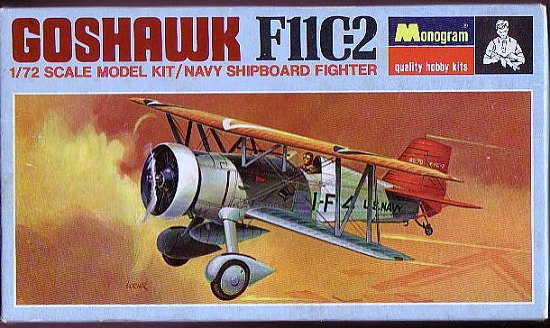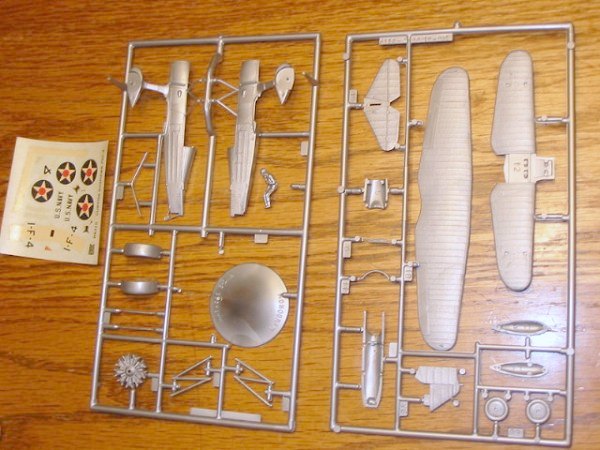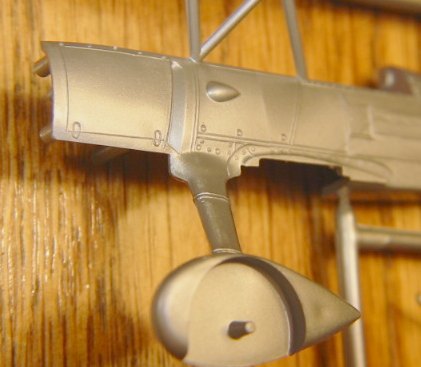
|
KIT: |
Monogram 1/72 F11C Goshawk |
|
KIT # |
PA 210 |
|
PRICE: |
$.70 in 1968 |
|
DECALS: |
One aircraft, VF-1B from USS Saratoga 1933 |
|
REVIEWER: |
|
|
NOTES: |
A great old kit, very good exterior detail, but no interior. |

|
HISTORY |
In 1932, 28 Goshawks were ordered by the US Navy. One was used as the basis for a special conversion, while the other 27 were delivered in 1933 to VF-1B, aboard the USS Saratoga. The planes only existed as F11C-2s for a short period—in 1934 they were re-designated BFC-2 (Bomber-fighters). VF-1B (the High Hats) flew the Goshawk from 1933 until 1938. VF-1B was the only squadron to use the Goshawk in active service from a carrier.
The F11C-2 was a fairly small aircraft, with a wingspan of 31.5 feet, and a length of 22.5 feet. The aircraft was armed with two Browning .30 cal machine guns, and could carry a 500 pound bomb in place of the streamlined belly tank. Typical of many aircraft of the era, the plane was of metal construction, with fabric covered wings. The fuselage was a mix of fabric and metal. Landing gear was fixed, with streamlined wheel pants.
|
THE KIT |

In the late 1960s, Monogram released a series of 1930s US Army and US Navy aircraft in 1/72 scale. Other biplanes included the Curtis P-6E Hawk, and the Boeing F4B-4. All three kits featured similar engineering, with the cabane struts and landing gear molded into the fuselage, to provide error-free alignment for young builders. All the aircraft in the series included a round pedestal stand, as well.
The subject for this review is from the original production series. The kits were re-released a couple of times, but I think the early 1980s was the most recent one.
The model is molded in silver plastic, following the
practice of minimizing painting by molding in the most common color.
Detailing consists of raised panel lines and rivets, and a finely engraved
fabric effect. (As a point of comparison, the fabric effect is finer and more
subdued that what you’d find in Revell WW1 kits from the same era.)

The fuselage has petite panel, rivet and fabric detail. There is no interior, except for a place to put the instrument panel decal. A pilot figure is included, but he has doesn’t even get a shelf to sit on— he has a mounting pin on his leg that goes in a socket on the inside of the fuselage. A tiny clear plastic windscreen and tubular gunsight is included.
The engine is a separate molding, with a separate exhaust header. The engine detail is really quite good— with fine detail on the cylinder fins. The prop spins, provided you melt the end of the shaft using the old heated screwdriver technique. The ring cowl is a two-part affair.
Parts are generally well molded and free of flash. My example had a pronounced mold seam along the top wing’s leading edge, but it would be easy to sand away. Models from this era typically have sink marks in visible locations, and this kit is no exception. Both the top and bottom wings have marks that should be dealt with. The top wing has six marks on the lower surface. The bottom wing has a pair in the upper surface, between the legs of the N struts. These are the most visible marks on the model.
The instructions are a single 8.5 by 11 inch sheet of paper, folded into quarters. One side of the sheet has the four main steps for assembly. The other side has a picture of the model, a decent history, and nice three view with painting and decal instructions.
The small decal sheet offers markings for one aircraft. The aircraft is colorful: The upper surface of the top wing is bright yellow. The rest of the fabric covered areas are silver dope. The metal parts of the fuselage are light gray. The tail feathers are bright red, which identifies the aircraft as being from Saratoga.
The decals include wing stars, squadron codes, and some basic rudder stenciling. The white fuselage band and squadron codes are an integrated decal, to ease alignment. My kit’s decals are rather old looking, and I’m not sure how they’re going to hold up if used. I built the Boeing F4B-4 a few years ago, and the decals were fine, so if you get a kit with decent decals I think you’ll be OK. They were typical of monogram decals from the era— a little thick, but they went down well with a little Solvaset, as I recall.
|
CONCLUSIONS |
Highly Recommended. I have always liked these little biplanes. Monogram produced easy to build, decent looking models of colorful aircraft that no one else offered at the time. The models offer reasonable surface detailing, and easy assembly. True to their era, there is no interior other than a pilot, but if you use him, it will be hard to see what’s missing.
When they were originally released, these kits made it easy for a beginner to build a 1/72 biplane, and were a good first biplane subject. I’d say that is still true today.
Originally, I just dug this kit out of my stash to do the preview. But the more I handle it, the more I like it. This is really a nice kit. Instead of putting this one away, I’m going to build it!
|
REFERENCES |
The kit instruction sheet was used as the source for the aircraft history.
If you would like your product reviewed fairly and quickly by a site that has nearly 200,000 visitors a month, please contact me or see other details in the Note to Contributors.